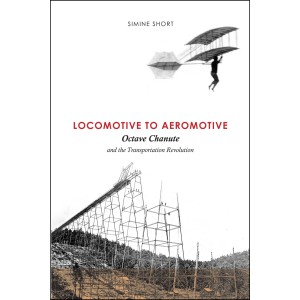Locomotive to Aeromotive - Octave Chanute and the Transportation Revolution
Author: Simine Short
Cloth Hardcover, 360 pages, 67 black & white photographs, 5 maps, 2 tables
Dimensions: 6.125 x 9.25 inches (165 x 235)
Release Date: August, 2011
Forward by Tom D. Crouch, Senior Curator, Aeronautics, National Air and Space Museum, Smithsonian Institution
The first in-depth look at an influential engineer and aviation pioneer
French-born and self-trained civil engineer Octave Chanute designed America's two largest stockyards, created innovative and influential structures such as the Kansas City Bridge over the previously "unbridgeable" Missouri River, and was a passionate aviation pioneer whose collaborative approach to aeronautical engineering problems encouraged other experimenters, including the Wright brothers. Drawing on rich archival material and exclusive family sources, Locomotive to Aeromotive is the first detailed examination of Chanute's life and his immeasurable contributions to engineering and transportation, from the ground transportation revolution of the mid-nineteenth century to the early days of aviation.
Aviation researcher and historian Simine Short brings to light in colorful detail many previously overlooked facets of Chanute's professional and personal life. In the late nineteenth century, few considered engineering as a profession on par with law or medicine, but Chanute devoted much time and energy to the newly established professional societies that were created to set standards and serve the needs of civil engineers. Though best known for his aviation work, he became a key figure in the opening of the American continent by laying railroad tracks and building bridges, experiences that later gave him the engineering knowledge to build the first stable aircraft structure. Chanute also introduced a procedure to treat wooden railroad ties with an antiseptic that increased the wood’s lifespan in the tracks. Establishing the first commercial plants, he convinced railroad men that it was commercially feasible to make money by spending money on treating ties to conserve natural resources. He next introduced the date nail to help track the age and longevity of railroad ties.
A versatile engineer, Chanute was known as a kind and generous colleague during his career. Using correspondence and other materials not previously available to scholars and biographers, Short covers Chanute's formative years in antebellum America as well as his experiences traveling from New Orleans to New York, his apprenticeship on the Hudson River Railroad, and his early engineering successes. His multiple contributions to railway expansion, bridge building, and wood preservation established his reputation as one of the nation's most successful and distinguished civil engineers. Instead of retiring, he utilized his experiences and knowledge as a bridge builder in the development of motorless flight. Through the reflections of other engineers, scientists, and pioneers in various fields who knew him, Short characterizes Chanute as a man who believed in fostering and supporting people who were willing to learn. This well-researched biography cements Chanute's place as a preeminent engineer and mentor in the history of transportation in the United States and the development of the airplane.
"An impressive, truly significant addition to the field of engineering and aeronautical history. Simine Short shows how Octave Chanute's personality and method of problem-solving enabled him to make meaningful contributions in diverse fields such as railroad and bridge engineering, stockyard design, and the early phase of aviation." --Robert W. Jackson, licensed glider pilot and author of Rails across the Mississippi: A History of the St. Louis Bridge
"As the first detailed biography of civil engineer and aeronautic pioneer Octave Chanute, this book fills a gap in the existing literature and is suitable for both the lay reader and the expert."--Anthony M. Springer, editor of Aerospace Design: Aircraft, Spacecraft, and the Art of Modern Flight
"We have waited a long time for a solid biography of Octave Chanute. Simine Short has given us a book worth waiting for. She succeeds in situating the details of Chanute’s long life and extraordinary career squarely in the context of his time.”--from the foreword by Tom D. Crouch, senior curator of aeronautics, National Air and Space Museum, Smithsonian Institution
About the Author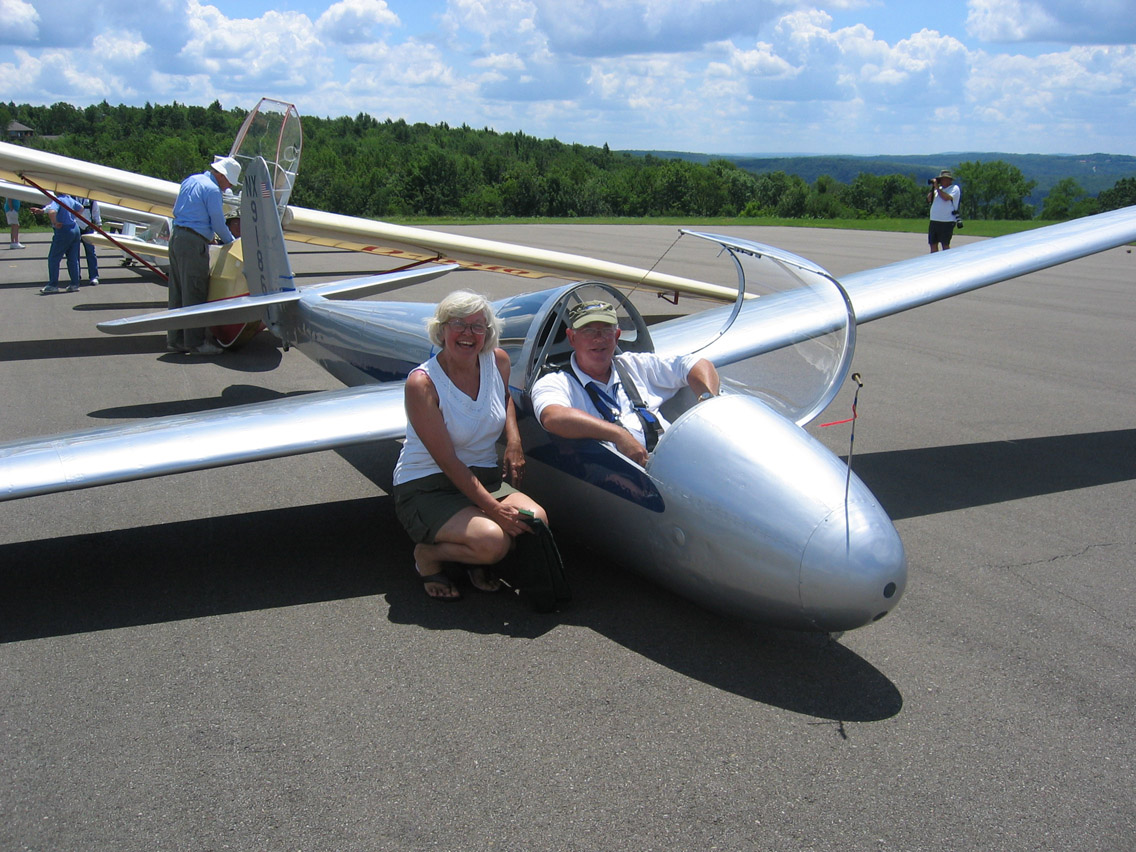
Simine Short is an aviation historian who has researched and written extensively on the history of motorless flight. Her first book, Glider Mail: An Aerophilatelic Handbook, received numerous research awards worldwide and is considered a standard reference by aero philatelists and aviation researchers. She lives with her husband (sailplane pilot Jim Short) outside Chicago, Illinois.
Dedication: "This book is dedicated to Jim, my favorite glider pilot, who is just as interested in the history of the sport as in flying."
Cool quote in the front of the book
"From the locomotive to the aeromotive," shouted the noisiest of all, who had turned on the trumpet of publicity to awaken the Old and New Worlds. … A flying machine must be constructed to take advantage of the natural laws, but it is not necessary to copy Nature completely. Locomotives are not copied from the hare, nor are ships copied from the fish. To the first we have put wheels, which are not legs; to the second we have put screws, which are not fins. Besides, what is this mechanical movement in the flight of birds, whose action is so complex? - Jules Verne, The Clipper of the Clouds (1887)
Review by Paul Remde
Few people (even well-read glider pilots) understand just how much Octave Chanute contributed to the development of aviation in the late 1800's and early 1900's. Did you know that hundreds of gliding flights were safely performed over the Indiana dunes near Lake Michigan in the years around 1896 in gliders designed by Octave Chanute? Did you know that he acted as a mentor to the Wright brothers and witnessed some of their early flights? At the 1904 World's Fair in St. Louis, William Avery performed glider flying exhibitions in a glider designed by Chanute and using an electric winch that was also designed by Chanute. Octave also acted as a clearinghouse of aviation information - meticulously collecting every document he could find on the subject and sharing them along with friendly letters of support to aviation pioneers around the world.
Simine Short has a passion for aviation history and has thoroughly researched and documented the life and work of Octave Chanute in this book. She also included many wonderful photographs and diagrams. Well done Simine!!!
As a mechanical engineer, MBA graduate, and glider pilot, I found the entire book very interesting. It is an amazing trip back in time - to the time of steam ships and steam locomotives. Octave Chanute was an amazing man, engineer, and pioneer. The first half of the book covers his early life and his work for railroads - helping them extend across the central U.S. He was a respected railroad bridge designer (first in wood - later in steel) and was responsible for innovated work in railroad tie preservation (life extension through the injection of preserving chemicals). Any glider pilot will find his life and accomplishments fascinating. The life history and engineering parts of the beginning of the book are a welcome look into what makes-up the character and experiences of the man - helping to explain his later aviation achievements. Glider pilots will find the last 1/3 of the book the most interesting - which details his aviation accomplishments.
The images below are from the Chanute Aquatorium in Marquette Park on the Miller Beach dunes on the shore of Lake Michigan in Gary, Indiana.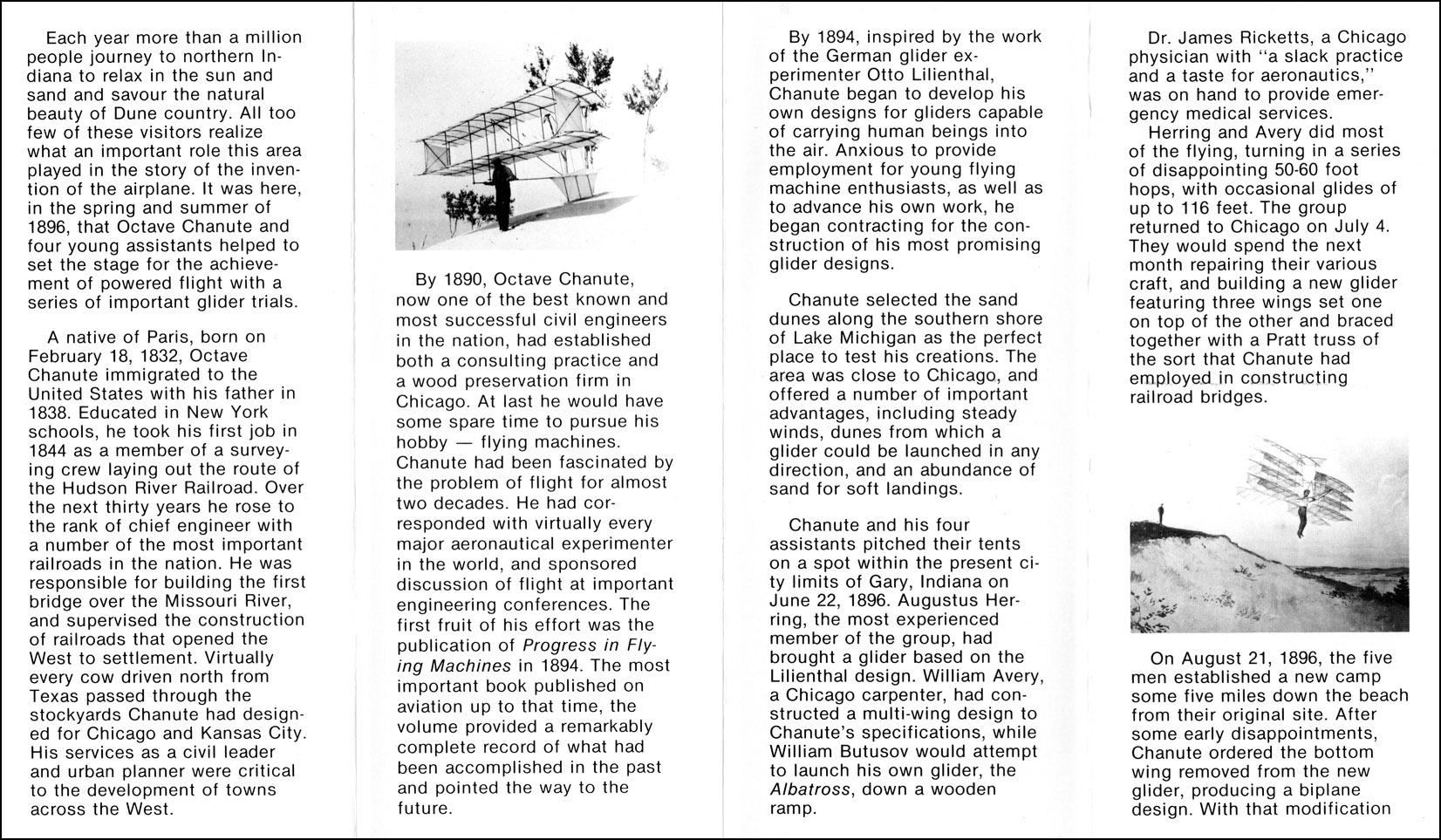
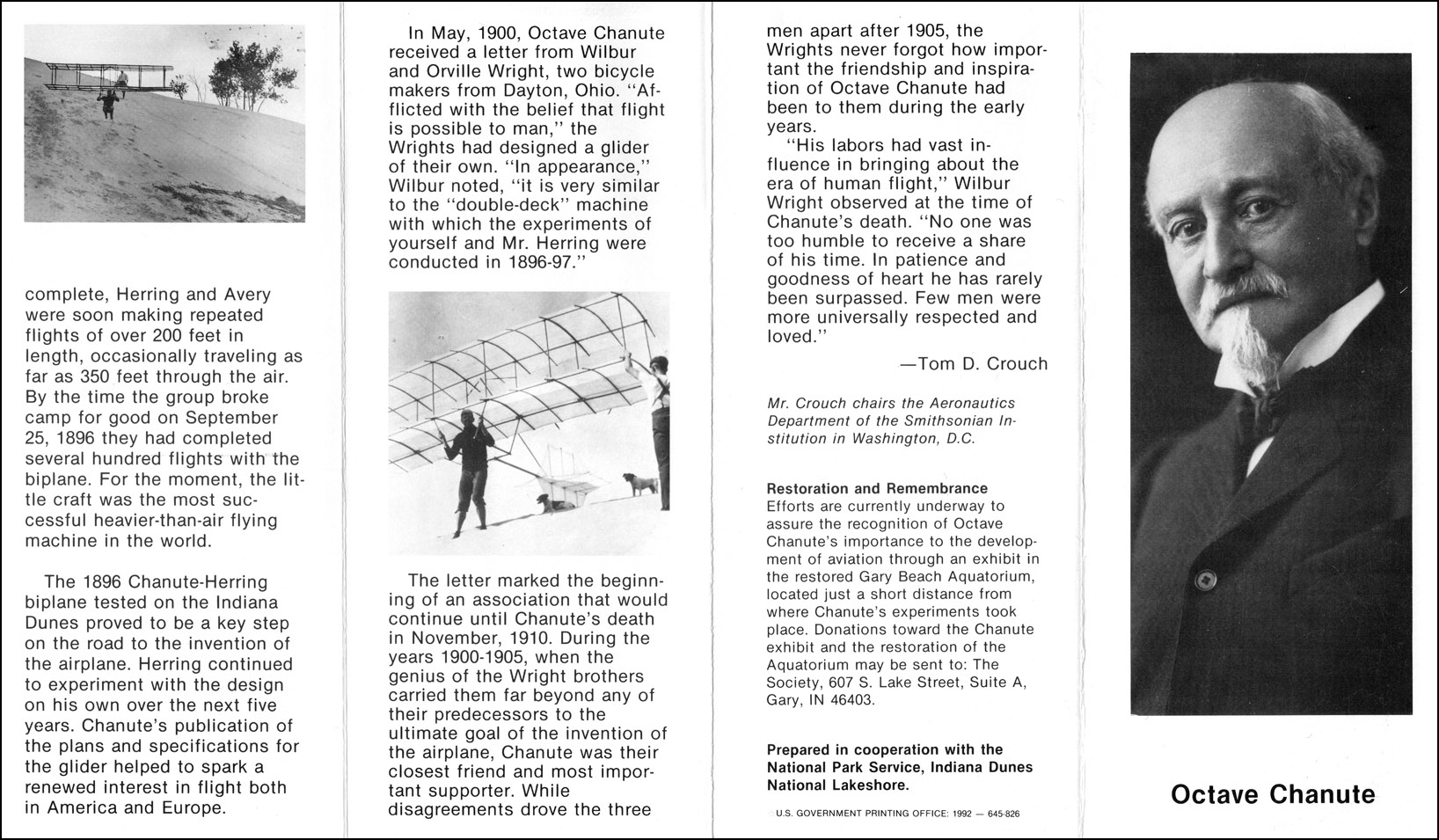
The 2 images above are the front and back sides of a brochure I found at the Indiana Dunes National Lakeshore Visitor Center in Porter, Indiana.
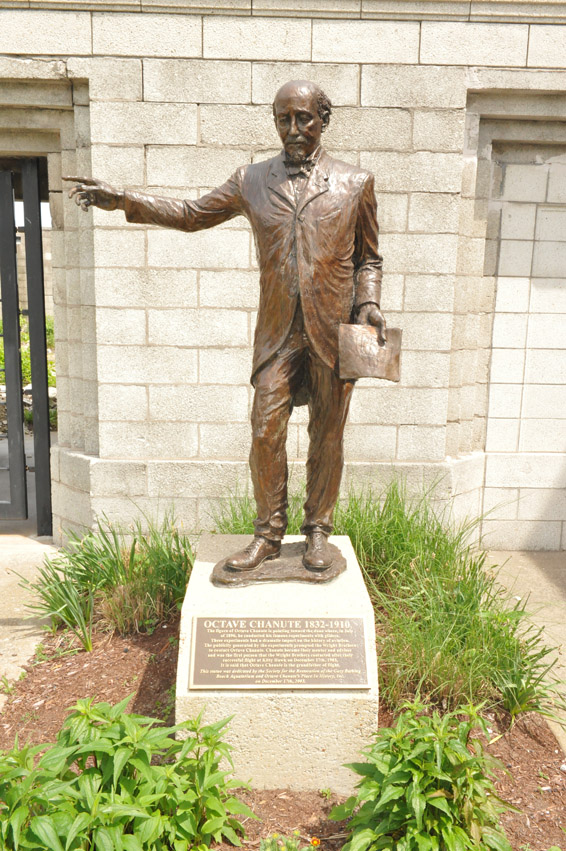
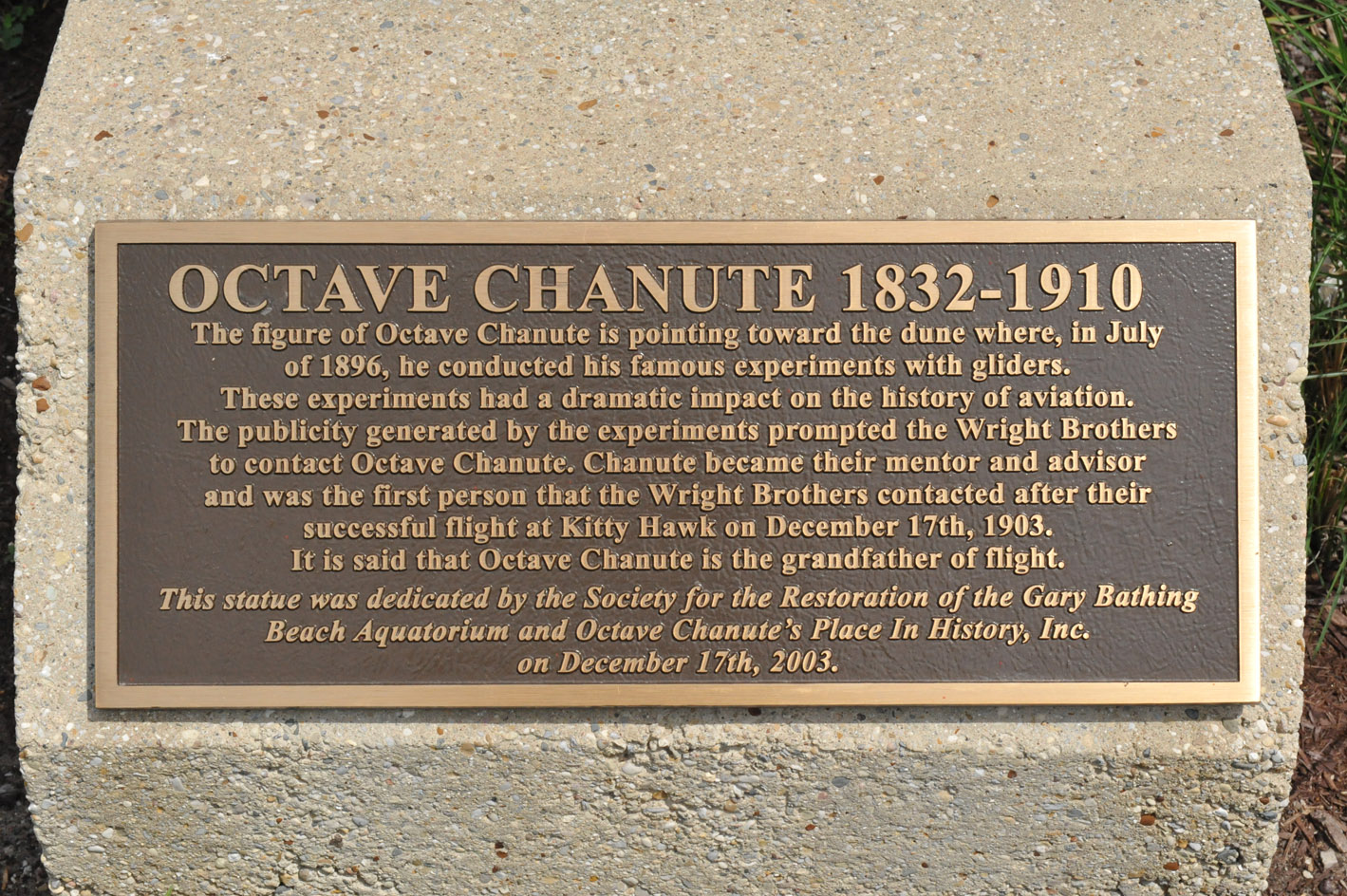
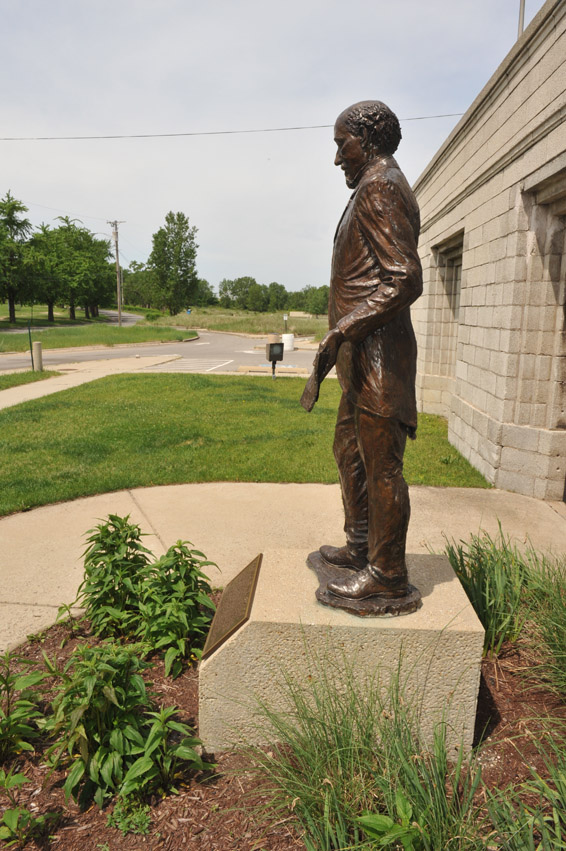
The Chanute statue, erected in 2003, is located in the front of the Aquatorium. The statue is pointing to the actual site on the dunes where his flight experiments took place. The dunes are somewhat overgrown - which may just protect them from disappearing.
Locomotive to Aeromotive - Octave Chanute and the Transportation Revolution
- Brand: books
- Product Code: Locomotive to Aeromotive
- Availability: In Stock
- $38.00
-
$29.00

